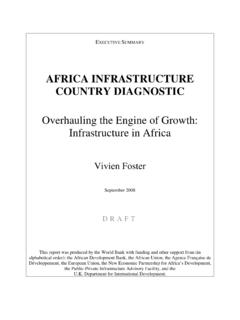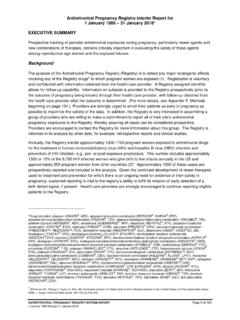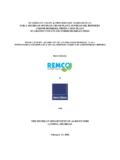Transcription of Report on Executive Compensation Compliance …
1 Report on Exempt Organizations Executive Compensation Compliance Project--Parts I and II. March 2007. In 2004, the internal revenue Service, through the Exempt Organizations Office of the Tax Exempt and Government Entities Division (EO), implemented the Executive Compensation Compliance Initiative (the Project). The Project encompassed Forms 990 and related returns for tax years beginning in 2002, and was divided into three parts. This Report discusses Part I, involving Compliance check letters sent to 1,223 organizations, and Part II, a separate project involving examinations of 782 organizations. Approximately 10% of the examinations remain open. Part III, which was initiated based on information gathered in Part II, will be discussed subsequently, as will our continuing work in the Executive Compensation Compliance area. SUMMARY OF FINDINGS. Significant reporting issues exist Over 30% of Compliance check recipients amended their Forms 990.
2 Fifteen percent (15%) of the Compliance check recipients were selected for examination. Examinations completed to date do not evidence widespread concerns other than reporting. However, as this was not a statistical sample, no definitive statement can yet be made concerning the Compliance level in this area. Continued work in the area of Executive Compensation is warranted. Where problems were found, significant dollars are being assessed (25. examinations have resulted in proposed excise tax assessments under Chapter 42, aggregating in excess of $21 million, against 40 disqualified persons or organization managers.). Although high Compensation amounts were found in many cases, generally they were substantiated based on appropriate comparability data. Additional education and guidance, as well as training for agents, are needed in the areas of reporting requirements, and the rebuttable presumption procedure that may be relied upon by public charities to establish appropriate Compensation .
3 Changes in the Form 990 series are necessary to reduce errors in reporting and provide sufficient information to enable the IRS to identify Compensation issues Part I and Part II utilized new Compliance contact techniques, which have since been refined in later projects such as Credit Counseling and Down Payment Assistance. Using those refined techniques and concentrating on particular industries, demographics and governance practices in future efforts should allow us to better assess and understand Compliance levels and enable us to identify and concentrate our efforts on noncompliant taxpayers. 1. BACKGROUND. In 1996, Congress enacted IRC section 4958, the intermediate sanction on excess benefit transactions. An excess benefit transaction occurs when a disqualified person 1 receives improper personal gain from the exempt organization. Rather than revoking the charity's tax-exempt status, section 4958.
4 Allows the IRS to impose an excise tax against the disqualified person and possibly the organization manager. In 2002, final section 4958 regulations were promulgated. Shortly thereafter, EO. created the Intermediate Sanctions Committee to coordinate all aspects of interpretation and enforcement of section 4958 and the final regulations issued thereunder, including helping identify and develop section 4958 issues. In 2004, EO formally implemented the Executive Compensation Compliance Initiative, designed to review Compensation practices of exempt organizations to identify tax administration concerns and potential areas of abuse in the exempt sector. The Project, which was managed by the Executive Compensation Compliance Initiative Team, included education and outreach components complemented by an examination program focusing on Executive Compensation paid by a broad range of public charities, as well as private foundations.
5 Project Objectives: Use the Exempt Organizations Compliance Unit (EOCU) and the Data Analysis Unit (DAU), the new offices created as part of the 2004. budget initiative, to impact a broader cross-section of the EO. community through correspondence and, where appropriate, traditional examination techniques. Increase awareness of Compensation as a Compliance issue within the charitable sector and establish an IRS enforcement presence in this area. Observe the practices and procedures exempt organizations use to determine Compensation of their officers, directors, trustees, key employees, and related persons. Assess and enhance tax law reporting and Compliance with respect to Compensation practices of exempt organizations. 1. A disqualified person is any person who was in a position to exercise substantial influence over the affairs of the tax exempt organization. See IRC 4958(f)(1). 2.
6 METHODOLOGY. EO contacted 1,826 exempt organizations 1,428 public charities and 398. private foundations regarding their executives' Compensation . Part I of the Project involved Compliance check letters sent to 1,223 organizations, and Part II. included 782 examinations, 179 of which resulted from responses to the Part I. Compliance checks. Part I. The Exempt Organizations Compliance Unit sent Compliance check letters to a sample of organizations whose Forms 990 and 990-PF fit within discrete categories of missing information indicating they warranted follow-up. The letters were sent to 1,023 public charities and 200 private foundations, representing a broad cross-section of the EO community. 2 The organizations included small, medium and large organizations, with approximately 70% self- classified by NTEE 3 codes as health, education, philanthropy, grant making and human services organizations.
7 The Project did not address churches or other organizations that are not required to file Form 990. The recipient organizations fell into five categories: Category A Category A involved 50 public charities with assets of $1 million or more and revenues of $5 million or more that had reported significant total Compensation , but failed to provide complete detailed information regarding the Compensation . Category B Compliance check letters were sent to 100 public charities of all sizes reporting receivables/loans from officers, directors, trustees, and key employees exceeding $100,000 or more. The letters requested the organization provide clarification of the loans or a required Form 990 schedule for line 50. Category C This category involved 378 public charities that either answered yes or failed to respond to the question of whether they had participated in an excess benefit transaction (question 89b).
8 Category D Category D involved 497 public charities that either answered yes . or failed to respond to the question about transactions with disqualified persons (question 2, Form 990, in Schedule A, Part III, Statements About Activities.). 2 Within each category, actual selections were made on the basis of available information and likelihood of issues on the return. At the time of selection, we recognized this as a first step on how to improve EO's selection process for Compensation cases. Given the varied results, selection criteria for the groups will be modified in future efforts. 3 National Taxonomy of Exempt Entities, a classification system developed by the Urban Institute and the Foundation Center. 3. Category E Category E was the only Compliance check letter sent to private foundations. These letters focused on 188 organizations that did not Report any officers' Compensation on line 13 of Form 990-PF.
9 The private foundations were asked either to check a block indicating no Compensation was paid, or to file an amended return providing the required schedule reporting officers'. Compensation . An additional 12 private foundations were contacted regarding loans to officers. Part II. The purpose of Part II of the Project, the Examinations Phase, was to determine whether the Compensation of disqualified persons was reasonable in accordance with IRC Chapter 42 and other Code requirements. During the process, agents also considered the private foundation rules against making loans to disqualified persons, the rules prohibiting purchase of charity assets at below market prices, and the rules against sales of disqualified persons' property to charities at inflated prices. The examination phase involved 782 organizations, made up of the organizations from the following four categories, plus an additional 179 which resulted from unsatisfactory responses to the Compliance checks.
10 Category 1 The first category of examinations involved 100 small public charities with assets of less than $1 million and revenues of less than $5 million;. these organizations reported significant amounts of Compensation in Part V for one or more of their officers. Category 2 The second category of examinations involved 208 larger public charities. These charities had assets of $1 million or more and revenues of $5. million or more; they too reported significant amounts of Compensation in Part V. for one or more officers. Category 3 The third category of examination involved 97 public charities chosen through a sample of Form 990s with Part V completed. Category 4 The last category of examinations involved 198 private foundations reporting significant officers' Compensation on line 13. 4. FINDINGS. Overall The Project shows mixed results regarding reporting and Compliance by the contacted organizations.
















